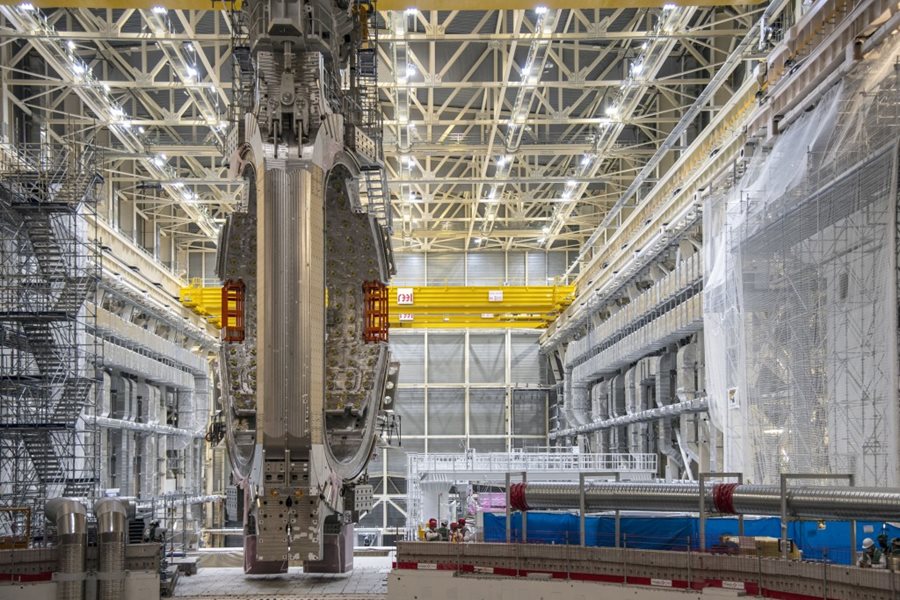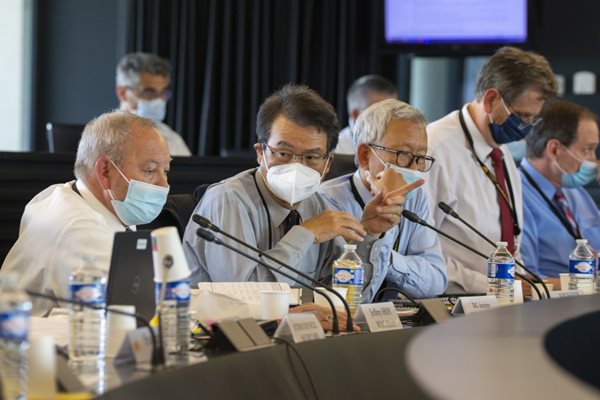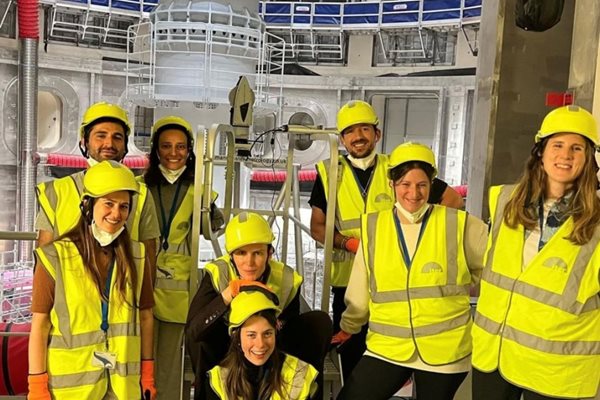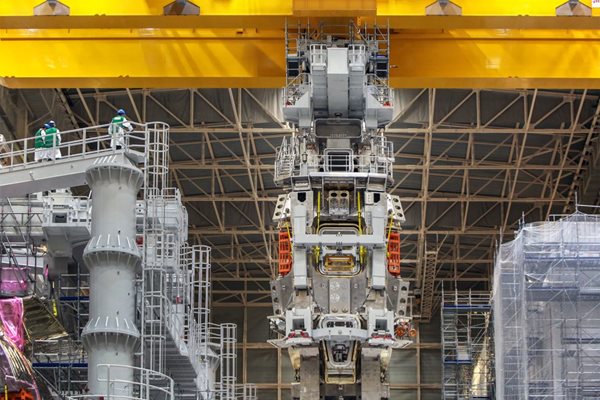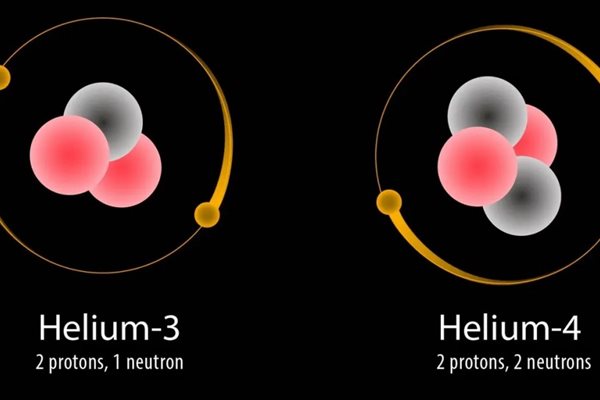
you're currently reading the news digest published from 16 May 2022 to 23 May 2022
featured4
of-interest3
press39
featured
Tokamak assembly | The "module" has landed
This 'module' was not designed to land on the Moon. But it was as complex a piece of technology, requiring as much precision in its handling as the famed 'lunar modules' of the Apollo project that made history more than 50 years ago. In the ITER world, a 'module' is an assembly of one vacuum vessel sector, two vertical D-shaped coils and corresponding thermal shield panels, plus all kinds of piping and appendices that bring the sub-component's total mass to 1,380 tonnes—the equivalent of four fully-loaded Boeing 747s. On 11-12 May, the first of the nine modules required for the tokamak's torus-shaped vacuum vessel was slowly extracted from the sub-assembly tool, lifted and transported over the wall separating the Assembly Hall from the machine assembly pit, and positioned with sub-millimetric precision on its supports. Although the machine assembly sequence has offered many spectacular operations since May 2020, the lifting and landing of this first sector module eclipsed them all. It was both a magnificent performance and a unique demonstration of technological mastery. The long-expected operation was more than a year in planning. It tested the limits of the building's structure, of the overhead crane's lifting capacity, of the complex rigging's manoeuvrability and, perhaps most of all, of the coordination of a 50-person team belonging to half a dozen different companies and organizations. At each and every stage of the component's journey—from the pre-assembly tool to the final resting position in the assembly pit—clearances were minimal. It was indeed an extraordinary spectacle to watch: the massive load practically grazing the different structures it encountered on the way to its final destination. Four centimetres of lateral clearance during the extraction procedure from the sub-assembly tool, 20 centimetres vertically as it passed over the pit wall, 7 centimetres during lowering ... Due to the inevitable 'swing' created by the pendulum effect, the clearance throughout the whole operation was reduced, down to 5 centimetres in a few positions. One of the main challenges, considering the composite nature of the load, was to determine its centre of gravity—an essential parameter in guaranteeing the safety and fluidity of the transfer operation. 'What we had in fact were two loads in one, each with its own centre of gravity,' explains Daniel Coelho, the ITER assembly engineer who coordinated the lifting. 'Long before we started the operation, when the module was still inside the pre-assembly tool, we precisely characterized its dimensions and weight, performed calculations, and established 3D models in order to obtain theoretical alignment targets. Theoretical data however, is only a starting point. You don't have an absolute certainty before actually starting to lift, and this is why the pre-lift operation a few days ago was so important.' Like Daniel, the operators involved all have experience in heavy, precision lifts in demanding environments, mostly nuclear. 'The difference here is that we are in a first-of-a kind context. We have the quality constraints of the nuclear world, but with highly specific components and extremely tight clearances that require unique lifting equipment, techniques and procedures.' How did they overcome such a daunting challenge? 'We compensate with thorough calculations and models, the qualification of operations, and exceptional safety measures,' smiles Daniel. But the outcome of such an operation does not rest on technology only. Men and women, working as a perfectly coordinated team—Daniel calls it 'a family'—were instrumental in its success. 'The contractors had prepared extremely well for every action, and the integration with the ITER Organization teams was faultless.' At the close of the day on Wednesday 11 May, the module, still attached to its rigging, was hovering a few centimetres above its supports. More metrology, some further meticulous adjustments ... and by the following day, the sector module was solidly and precisely moored in its near-final position. Inside the assembly pit, the view was striking. Although only one-ninth of the vacuum vessel torus, the component seemed to dwarf everything around it. The operation was coordinated by the ITER Organization construction team and its management-as-agent contractor MOMENTUM, and executed by tokamak assembly contractor DYNAMIC SNC (Ansaldo Nucleare; Endel Engie; Orys Group ORTEC; SIMIC; Ansaldo Energia; and Leading Metal Mechanic Solutions SL), crane operator Foselev, and GEATOP metrologists, with the support of APAVE health and safety officers. Read the press release in English or French. See the related video in this issue.
Transition | Eisuke Tada takes over the leadership of the ITER Project
Eisuke Tada, from Japan, assumes the interim role of Director-General of the ITER Organization in the wake of the passing of Director-General Bernard Bigot. Deputy Director-General of the ITER Organization since 2015, Eisuke Tada has been appointed by the ITER Council in the interim role of Director-General with full powers, responsibilities and authority. Dr Tada takes over leadership of the project until a long-term successor to Dr Bigot has been identified and is ready to take office. A widely respected leader in the fusion community and a seasoned veteran from ITER's earliest days, Dr Tada has dedicated most of his professional life to fusion energy and, more particularly, the ITER Project. Eisuke Tada entered the world of fusion research immediately after his training as a mechanical engineer, accepting a position at the Japanese Atomic Energy Research Institute JAERI (now, the National Institutes for Quantum Science and Technology). JAERI, at the time, was building one of the six toroidal field coils of the Large Coil Task, a joint Euratom, US, Japanese and Swiss collaborative venture to demonstrate the design principles and fabrication techniques to be applied in the construction of a superconducting tokamak. Dr Tada spent more than 10 years helping to develop the technologies and the infrastructure for large high-field magnets and was responsible in particular for designing advanced technology for the circulation of supercritical helium. A few years after the decision to build ITER was made, he was asked to contribute to the ITER Conceptual Design Activities in Garching, Germany, where he spent 18 months on the effort to define the technical characteristics of the ITER Tokamak. Dr Tada went on at JAERI to successively manage and coordinate the early design of ITER Tokamak components such as the double-walled vacuum vessel and remote handling equipment, lead the effort to establish site and safety standards, and establish codes and standards for the development of ITER mechanical components. Also during this time, he directed the Joint Work Site for ITER in Naka, Japan—part of the ITER Engineering Design Activities phase (1992-2001) to create the engineering drawings and models for the construction of the planned tokamak. As the negotiations for locating the ITER Project accelerated, Dr Tada was closely involved first in assessing multiple candidate sites in Japan, and then as part of the international board considering the proposals of the final four candidates. When the project site in France was selected, Dr Tada was one of the seven ITER Organization 'pioneers' who arrived to open the office in 2006. Between 2007 and 2010, he held the strategic positions of Head of Project Office and Head of Office for Central Integration & Engineering, supervising over 100 staff and developing the tools to develop and execute the project baseline structure (technical scope, schedule and cost). He created the earliest ITER Organization-Domestic Agency coordination team to smooth the interaction of the newly created domestic teams and collaboration on interface and procurement issues. He went back to the Japan Atomic Energy Agency (formerly JAERI) between 2010 and 2015, becoming the Head of the ITER Japan Domestic Agency, with responsibility for supervising all in-kind contributions to ITER, and Deputy Director of the Naka Fusion Institute. In May 2015, Eisuke Tada returned to the ITER Organization as Deputy Director-General, appointed by the ITER Council to collaborate closely with the ITER Director-General and other top executives in the day-to-day management of the ITER Project. In his message to ITER staff, Eisuke Tada wrote, 'The challenges that lie ahead are well known to us all. We have committed to deliver the ITER Project as a first-of-a-kind hydrogen fusion plant, but also as a collaboration among all seven ITER Members—a unique opportunity to leave a better energy legacy for our children and future generations.'
On site | A visit from Gabriela Hearst and the Chloé team
The ITER Project is renowned for being on the cutting-edge of many fields of design—but fashion design, haute couture, is not one of them. So it was a fascinating collision of two worlds when ITER recently played host to a team from Chloé, the luxury Paris fashion house, and its creative director, Gabriela Hearst. Named by the Financial Times as one of the top 25 Most Influential Women of 2021, Ms Hearst has become a trailblazer driving sustainability in fashion. When she learned about ITER and fusion—also, she says, through a 2021 Financial Times article—it was a revelation. A visit to ITER made the top of her wish list. 'Anyone that has been close to me has heard my intensity & focus on Fusion for the last five months,' she wrote. 'It was a privilege and probably one of the most fulfilling days of my professional career to visit ITER as part of our Fusion research with the Chloé Team.' What draws a fashion designer to the engineering and science of fusion energy? For Gabriela Hearst, the narrative can be traced, in a single continuous thread, to her roots growing up on a Uruguayan farm. Whether designing a new fabric, sourcing a supply chain, running her family farm (she still does!), or learning about a source of energy that could transform the future, life is about staying true to our connection to the earth, to leaving a better planetary legacy. Within this vision, fusion is a natural fit, 'part of our inspiration that will provoke learning and sharing a pathway solution to climate success.' The Chloé team donned their 'ITER fashion gear'—hard hats, reflective vests, gloves, and steel toed safety boots—with aplomb, taking in the scale and scope of ITER components, the details of the Assembly Hall and Tokamak pit, with an eye for detail and patterns. To see ITER through the eyes of Gabriela Hearst, see the work of Chloé videographer Alex Pommier on Instagram here. Or stay tuned: rumour has it that a fusion-focused fashion show may soon be in the works ...
Video | Watch the Big Lift!
A component towering six storeys high and weighing the equivalent of four fully loaded Boeing 747s is lifted out of tooling and transferred into the assembly pit. Believe us, you'll want to see the video below. The 1,380-tonne 'piece' of the ITER machine that was installed on Wednesday 11 May represents one-ninth of the toroidal plasma chamber. In ITER language it is a "sub-assembly," formed from one 40° vacuum vessel sector fitted with silver-coated thermal shields, and two D-shaped vertical superconducting electromagnets called toroidal field coils. The video below brings you close enough to the action to grasp the precision demanded of the models and measurements, the unity of the different teams, the skill of the crane operators, and certainly the months of careful planning and rehearsal that make the spectacular operation look ... easy. Watch it on the ITER YouTube channel here.
of-interest
Helium-3: why go the Moon?
Fusion can theoretically be achieved by several combinations of light elements such as hydrogen, helium or boron. However, in the present state of technology, the only fusion within our reach at industrial level is that of deuterium (D) and tritium (T), both isotopes of hydrogen. DT fusion however has one downside—it generates highly energetic neutrons that activate and alter the structures they bombard. (The good side of fusion neutrons is that they will be used to breed tritium from lithium inside the machine). For decades, fusion physicists have pursued what is sometimes referred to as the 'Holy Grail' of fusion: the fusion combinations that involve helium-3, which, instead of generating neutrons like in DT fusion, produce highly energetic protons. Advantages: no material activation or alteration and, protons being charged particles, the possibility of direct electricity generation (they can be manipulated by electric and magnetic fields). Downside: helium-3, which abounds on the Moon (hence the renewed interest for lunar exploration) is exceedingly rare on Earth. Now, scientists at the University of California San Diego have discovered evidence that helium-3 could be much more abundant on Earth than previously known. Led by Benjamin Birner, a postdoctoral scholar in geosciences, the team is developing tools and measurement methods to quantify the puzzling increase of helium-3 in the atmosphere, and understand where it could be coming from. We might not need to go to the Moon, after all, to mine the fuels for second or third-generation fusion power plants. Read the full story on Vice website.
ITER International School: pre-register before 1 June
Pre-register before 1 June 2022 for this year's ITER International School on the topic of "ITER Plasma Scenarios and Control." This in-person event will be held from 25 to 29 July 2022 at the University of California San Diego, hosted by the U.S. Burning Plasma Organization, the ITER Organization, UC San Diego, and General Atomics.Most attendees will be graduate students, post-doctoral researchers, and early career faculty and research staff working in fields relevant to the ITER program. Although the agenda will focus on topics of scenarios and control, attendees are not required to be working in these subfields. All nationalities, whether representing an ITER Member or not, are welcome.To register, see this webpage.
360° tour updated (April 2022)
The virtual tour of ITER construction has been updated with 360° photos from April 2022. Enter the main ITER plant buildings, fly over the worksite, and plunge 30 metres into the ITER Tokamak pit to see what has changed since the last update in September 2021. Accessible from the home page of the ITER website (yellow icon) or by clicking on the link below. Click here to enter the latest 360° ITER virtual tour.
